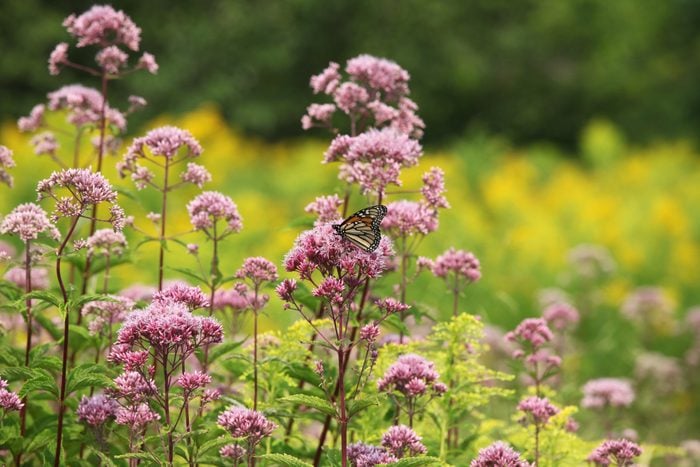
How to Choose Native Plants for Northern Climates
Stand in any wild green space and you’ll see the incredible diversity of nature. Some native species have been growing here for centuries, while selections of those blooming plants, or new plants made by crossing species, have given rise to native cultivars.
Most garden centers tend to sell cultivars, but specialty nurseries and mail-order sources offer a broader range of native species. Here, we’ll describe some of each.
Shopping for native plants isn’t much different from shopping for other perennials and shrubs. Some key features to look for when picking the best specimen off the bench include:
- Healthy, richly colored foliage without signs of extensive insect damage or disease.
- Signs of new growth.
- Straight, non-crossing or rubbing branches on woody plants.
- A plant that matches the picture on the label, so you know you’re buying the right variety.
We’re focusing here on extremely hardy native shrubs, perennials and ornamental grasses that tolerate the extremes of U.S. Department of Agriculture Hardiness Zone 3 (minus 30 F to minus 40 F). Our list includes plants that bloom throughout the year, as well as some evergreens and many perennials that pollinators adore. Let’s take a closer look.
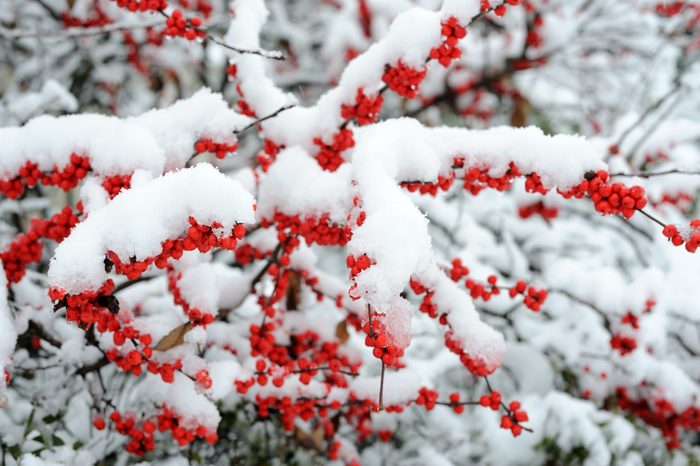
Winterberry Holly
Unlike most of the plants in your landscape, wintertime is when winterberry hollies (Ilex verticillata) shine the brightest. Imagine seeing these fiery red berries out your window on the coldest days of the year — a welcome sight indeed!
Because the fruits takes some time to soften, birds typically wait until mid- to late-winter to devour them, leaving more time for you to enjoy their color.
Native to the eastern half of North America in USDA Zones 3 to 9, winterberries need moist, acidic soil to thrive in sun to part shade. There are male and female cultivars, and you’ll need one male planted within 50 feet to pollinate up to five females for berries to form. ‘Winter Red’ and Berry Poppins are popular cultivars. Have you heard about the Keystone plant? This native plant is crucial to the food web and ecosystem.
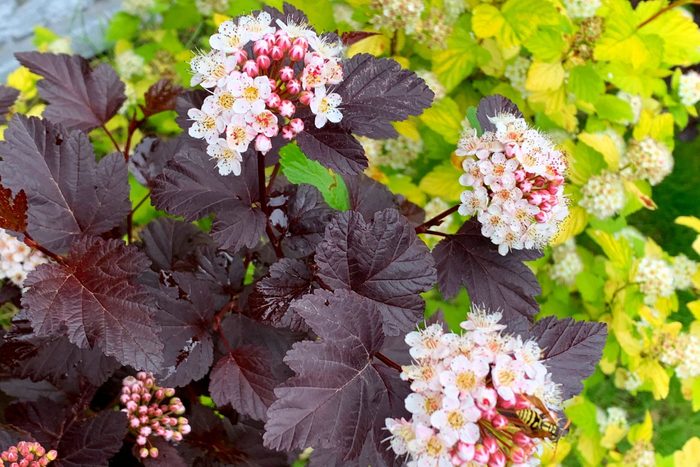
Common Ninebark
Beloved by honeybees and birds for its seeds and the shelter of its robust, arching stems, common ninebark (Physocarpus opulifolius) is a joy to grow.
Although the native species is green, you’re more likely to find cultivars with deep purple, reddish-bronze and gold foliage at garden centers. Little Devil and Ginger Wine are both excellent cultivars. Check the sizing carefully before you buy; ninebark can range from a small plant at just a few feet to a tall plant at 10 feet.
Ninebark adapts easily to a wide range of soil conditions, from moist to drought, so you’ll surely find a suitable spot in your landscape to plant one. In Northern climates through USDA Zone 3, it grows best in full sun. But in warmer USDA Zones 7 and 8, plant ninebark in filtered afternoon shade.
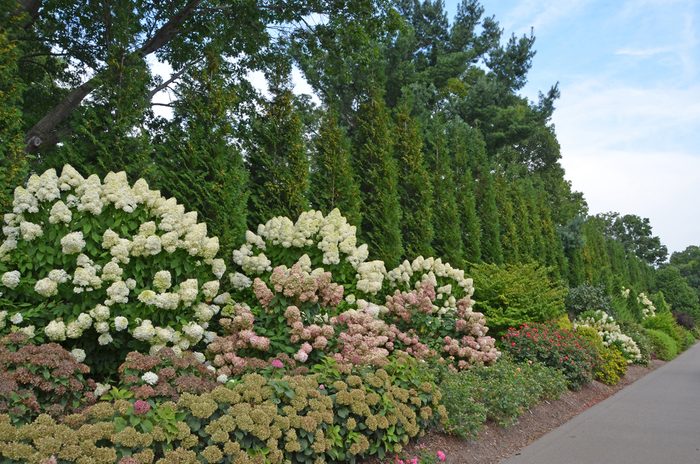
Eastern White Cedar
Eastern white cedar (Thuja occidentalis), also known as Eastern arborvitae and Northern white cedar, has become so ubiquitous in gardens from Northern Canada USDA Zone 2 to North Carolina USDA Zone 8 that it’s easy to forget they’re native shrubs.
Beloved for its emerald green, evergreen foliage and tidy conical or rounded shape, it makes great hedges and privacy screens in full sun to light shade.
You’ll find many fine cultivars for sale, including ‘American Pillar’ (shown here). Growing up to three feet per year, this 15- to 20-ft.-tall conical evergreen maintains a narrow three- to five-foot-wide base, so it won’t eat into your yard space. For a much shorter hedge (one foot), use the cultivar Mr. Bowling Ball.
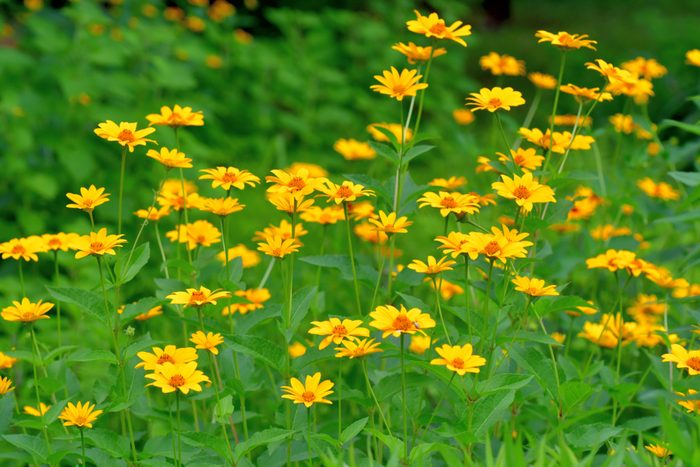
Oxeye Daisy
If you garden in clay soil and struggled to grow wildflowers, try oxeye daisies (Heliopsis helianthoides). They prefer heavy, moist soils and even thrive in alkaline clay. If you leave open ground around them, they’ll self-sow in your garden.
Occurring naturally in partially shaded open woods and sunny fields from Quebec to Texas, these glowing golden yellow daisies are a favorite of goldfinches, which are often found pecking away at the plant’s seed heads.
Although its stems stand up to six feet tall, shorter cultivars, like ‘Summer Nights’ and one with variegated leaves named ‘Sunstruck’ make good garden plants in tighter spaces.
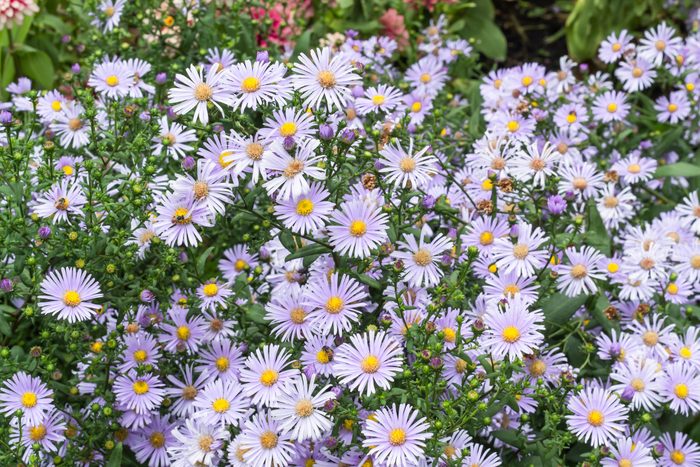
New England Aster
Among the many beautiful and hardy native aster species, you’ll find the New England aster (Symphyotrichum novae-angliae) readily available. Don’t be deceived by the name; it’s native across most of North America except the southernmost U.S. Try it in USDA Zones 3 to 8.
You might notice this wildflower blooming in moist, sunny meadows as you drive through the countryside in late summer or autumn. Look for its bright purple to pale blue blossoms dancing on tall stems among native goldenrod and big bluestem grasses.
Although the species can reach three to six feet tall, you can pinch its stems back several times before mid-July to keep the plant shorter and fuller.
Besides bringing a last hurrah of color to your garden, native asters are an important source of nectar for pollinating bees, Monarchs and several other species of butterflies.
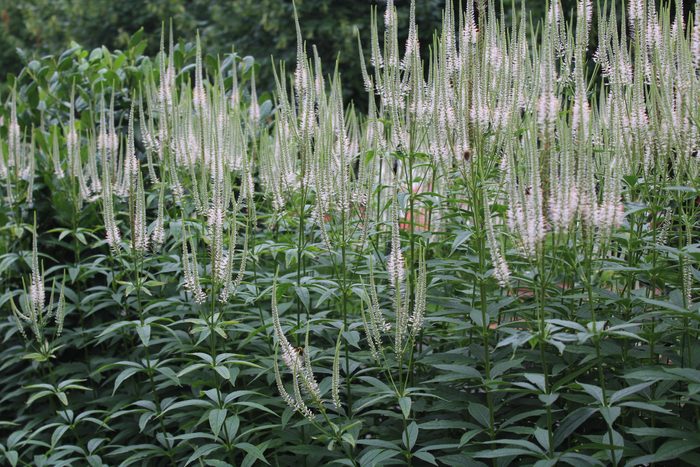
Culver’s Root
If you’ve hopped on the trend of growing a moon garden, here’s a remarkable native perennial that will fit right in.
Beginning in early summer and lasting for months, culver’s root (Veronicastrum virginicum) produces impressive, candelabra-shaped panicles of sparkling white blossoms on stems that can reach six feet tall. Numerous types of native bees and butterflies enjoy their nectar.
This perennial looks a lot like speedwell (Veronica) when it’s in bloom, but its dark green, whorled leaves and tall, unbranched stems help to distinguish it. Except for the Deep South, culver’s root grows and blooms best in full sun in USDA Zones 3 through 8.
You’ll know it’s getting too much shade if the stems flop and need staking. If you have a sprinkler system or a spot where the soil tends to stay moist most of the time, you should have good luck growing this distinctive wildflower.
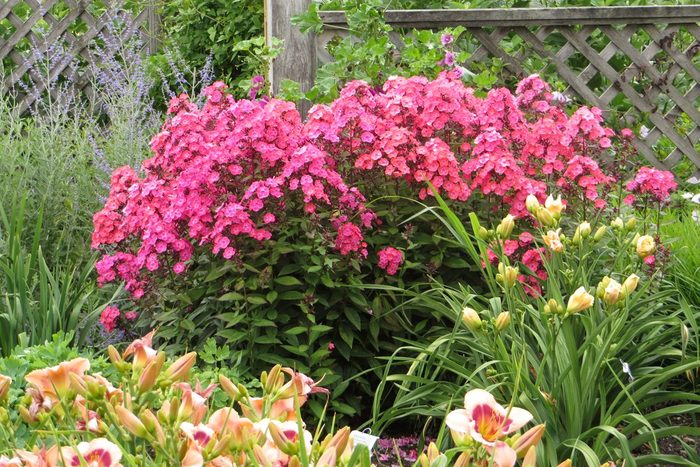
Tall Garden Phlox
About 60 native species of Phlox occur in North America, but tall garden phlox (Phlox paniculata) is easily one of the most impressive.
Strong three- to five-foot-tall upright stems carry its cheerful fragrant blossoms, the size of a jumbo grapefruit, from midsummer to fall. Bumblebees, honeybees, butterflies and hummingbirds are all frequent visitors when this USDA Zone 3 through 8 hardy perennial is in bloom.
Within a few years of planting your first tall garden phlox, the clump should be large enough to dig up and divide into a few pieces to transplant to other sunny or partially shaded places in your landscape. The more you make, the more you will have to cut and enjoy indoors in fresh bouquets.
Pictured here is ‘Glamour Girl,’ which is one of the most disease-resistant varieties you’ll find.
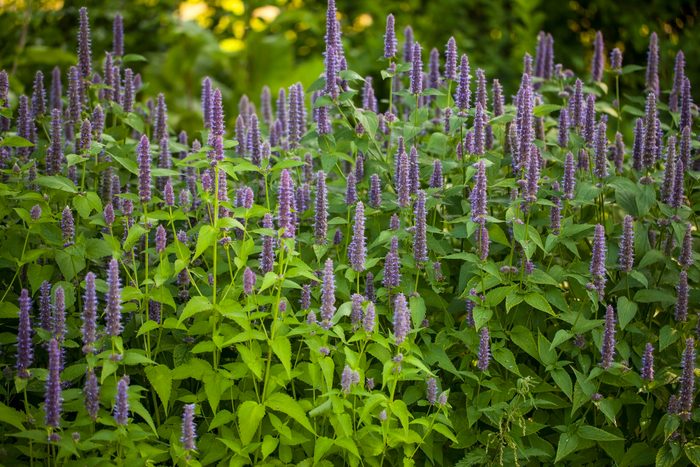
Anise Hyssop
For a parade of pollinators and birds all summer long, plant our native anise hyssop (Agastache foeniculum) which can be found growing across Northern North America.
This species is particularly favored by numerous types of native bees as well as butterflies, skippers, moths and hummingbirds. It’s not unusual to see a dozen pollinators enjoying the bright lavender-blue flower spikes at once. Goldfinches get in on the action, too, once the seeds are ripe.
To grow this ornamental edible herb successfully, you’ll need full sun and well-drained soil to prevent the roots from rotting. Little supplemental water is needed for it to thrive in USDA Zones 3 through 8.
This plant will self-sow, but that’s beneficial because the parent plant is often short-lived. The resulting seedlings are easy to transplant if they pop up in unwanted places.
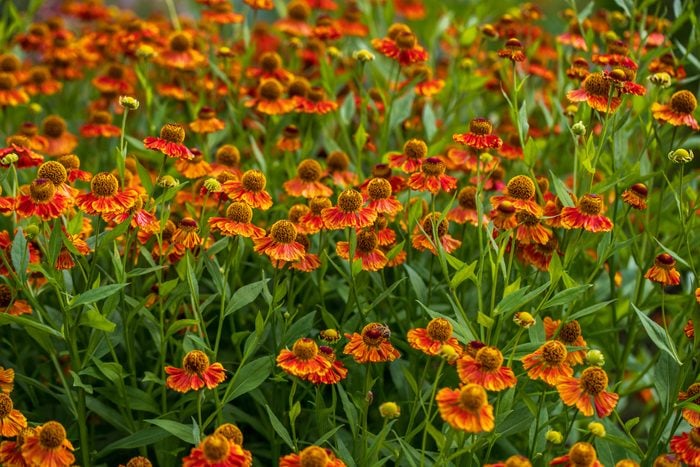
Helen’s Flower
If you enjoy the bold colors of fall mums but prefer to grow something more reliably hardy, try Helen’s flower (Helenium autumnale).
Both bloom around the same time. But because Helen’s flower is native to nearly all of North America in USDA Zones 3 through 9, it tends to be easier to grow, especially in clay soil. Moist soil is required to keep it happy and healthy, and a full day of sun will result in more prolific blooms.
While the native species typically tops out at three to five feet tall and blooms yellow, shorter cultivars like the knee-high Mariachi series comes in an array of reds, oranges and bi-colors. Short varieties like these don’t need to be pinched back like fall garden mums, which makes them a lower maintenance, hardier alternative.
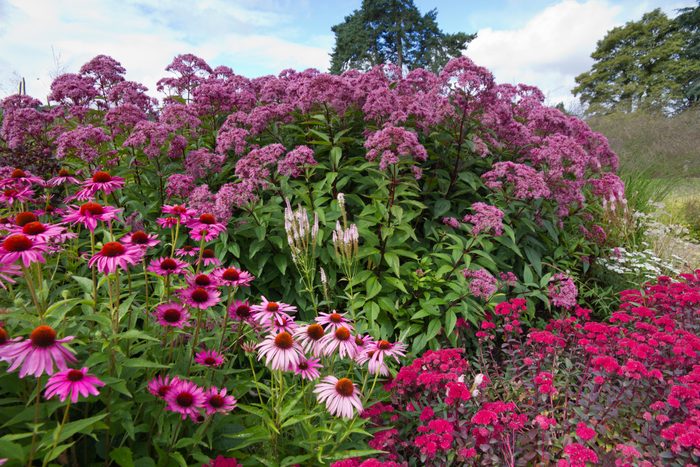
Joe Pye Weed
Every border needs a backdrop. This massive perennial (Eupatorium purpureum) happily takes its place in the back of the line where it stands a good six to seven feet tall. It grows quickly too, so you won’t have to wait years for it to fill in.
Thick, dense stems support huge domes of mauve-pink, vanilla-scented flowers perched on top from midsummer into fall. Expect to find pollinating bees and skipper butterflies picking through them collecting pollen on sunny days. Let the flowers dry naturally on the plant and its seed heads will provide winter interest.
This perennial requires moist, fertile soil. It thrives on low ground and along stream banks where it occurs naturally in USDA Zones 3 through 8. Filtered shade from tall trees above will be welcome in the warmest part of the season, although this rugged native also shines in full sun.
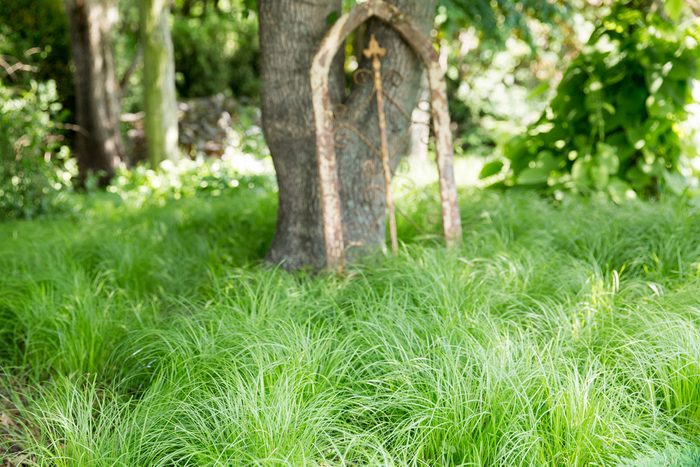
Oak Sedge
As more people look for native alternatives to turf grass, sedges are becoming popular and easier to find in retail stores. That’s good news for gardeners who want more lower maintenance, shade tolerant ground covers.
Oak sedge (Carex pensylvanica) flourishes in part to full shade and tolerates dryness, unlike turf which needs far more sun and water to grow well. Use it as a lawn alternative in USDA Zones 3 through 8.
Semi-evergreen oak sedge starts out as a softly arching, rounded clump of glossy, finely textured leaves. As it matures, the clump grows wider, but its habit stays fairly loose which makes planting other perennials in and amongst it an easy task.
It won’t overtake its neighbors like turf grass will. This native sedge has a beautiful, natural look about it that adds an element of grace to the garden.
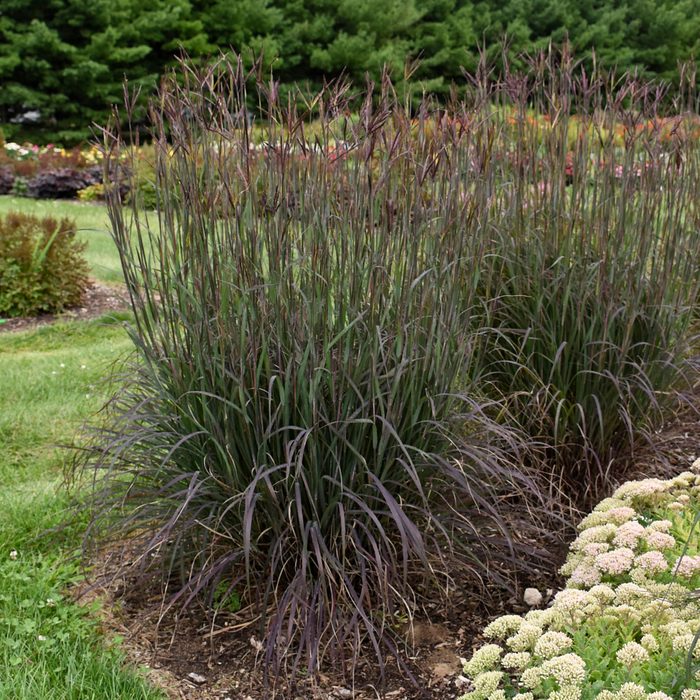
Big Bluestem
Nicknamed the “King of the Prairie,” our native big bluestem grass (Andropogon gerardii) once dominated North American prairies from Canada to Mexico. You won’t need a prairie to grow it, but you will need to give it some elbow room in your landscape. It thrives in full sun in USDA Zones 3 through 9 and tolerates a wide range of soils and growing conditions.
Big bluestem is a host plant for many insects and skipper butterflies, providing important habitat for small animals and birds. For most of the season, the foliage stays just a few feet tall. But in late summer, its impressive seed panicles soar up to eight feet. Cooler fall weather draws out striking scarlet and deep maroon tones, making this grass a true focal point in the landscape.
A popular cultivar ‘Blackhawks’ (shown here), takes on stormy purple tones late in the season. Look also for ‘Dancing Wind’ which turns vivid red.
